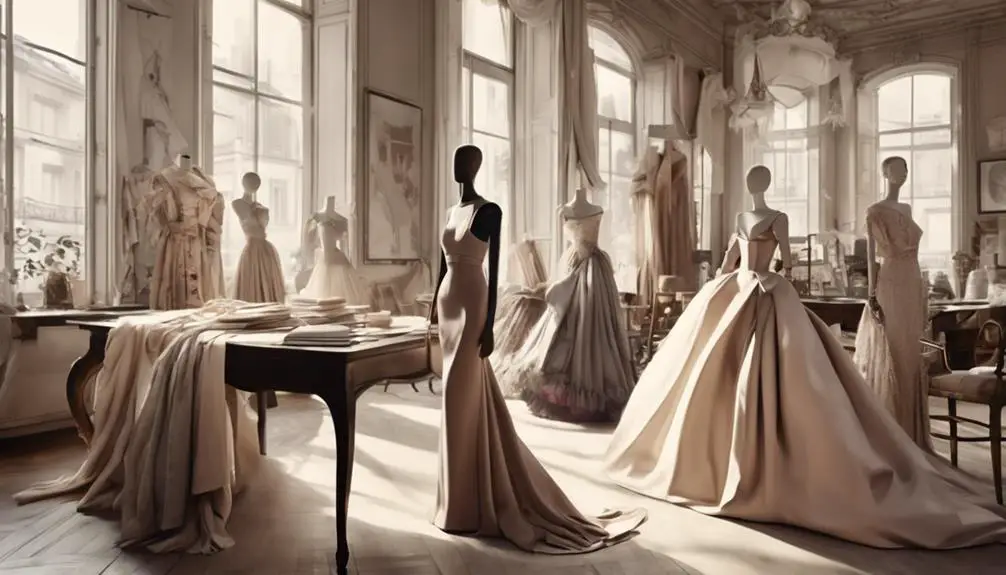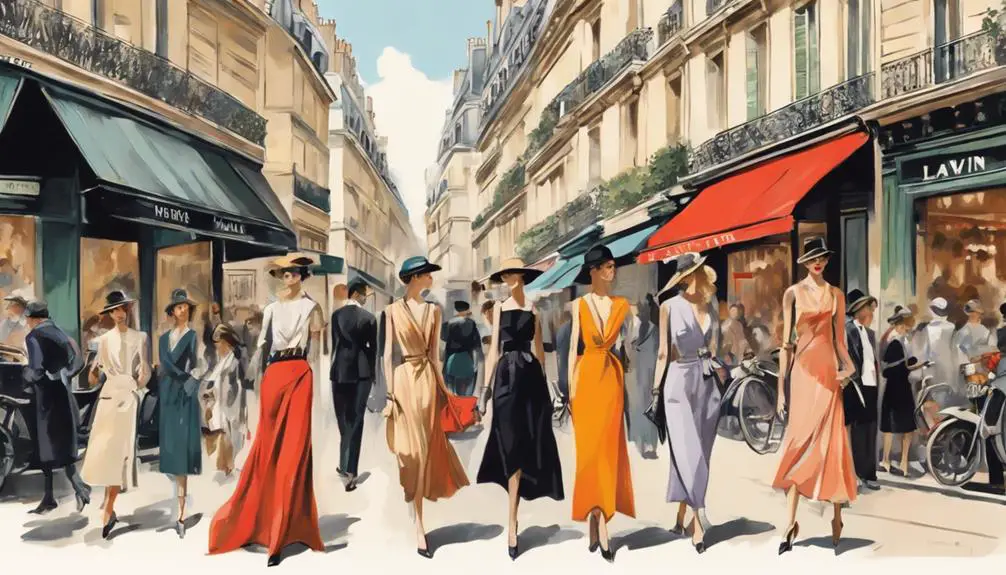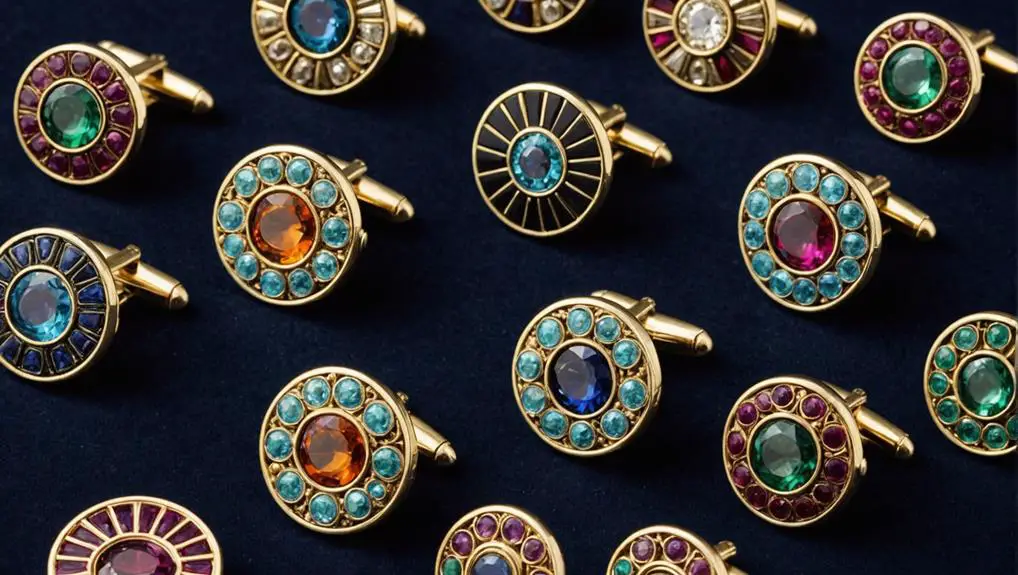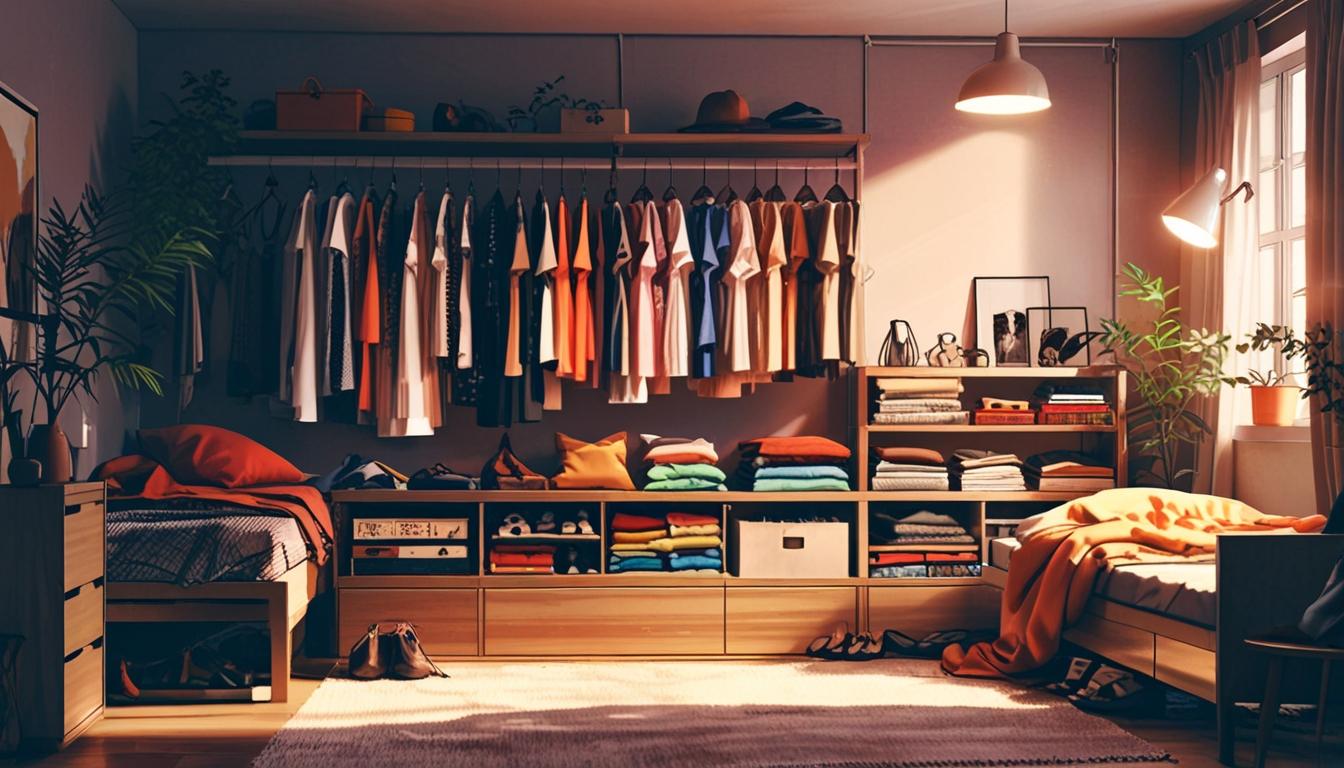The House of Lanvin started in 1889 when Jeanne Lanvin opened a small millinery shop in Paris. It quickly evolved into a high-fashion destination, famed for its elegant designs. By 1893, it had moved to a larger location and was renamed Mademoiselle Jeanne Modes, attracting fashionable Parisians. In 1908, Jeanne introduced a pioneering children's clothing line inspired by her daughter, Marguerite, solidifying her status in couture. By joining the Chambre Syndicale de la Couture in 1909, Lanvin became a legitimate couture house. This legacy of innovation and elegance continues to shape Lanvin's influence in fashion today, hinting at even more intriguing stories ahead.
Origins of Lanvin

Starting as a humble millinery shop in 1889, the House of Lanvin quickly evolved into a prominent fashion house under the vision of Jeanne Lanvin. Located at 16 Rue Boissy-d'Anglas in Paris, Jeanne's shop was a haven for stylish hats and accessories.
By 1893, she recognized the potential for growth and moved to a larger location at 22 Rue du Faubourg Saint-Honoré, laying the foundation for her eponymous fashion house.
As her designs gained popularity, fashionable Parisians flocked to the boutique, which soon became known as Mademoiselle Jeanne Modes. Jeanne's keen eye for style and detail helped her create stunning collections that captivated her clientele.
In 1908, she introduced a children's clothing line inspired by her daughter, Marguerite. This addition not only showcased her creativity but also became a significant aspect of the brand's identity, setting Lanvin apart from competitors.
In 1909, Jeanne Lanvin took another important step by joining the Chambre Syndicale de la Couture, solidifying her status in the fashion world. This membership recognized her as a legitimate couture house and elevated the brand's prestige.
The combination of her innovative designs and commitment to quality quickly established Lanvin as a leader in the fashion industry.
Today, you can trace the origins of this iconic house back to those early days of millinery, where Jeanne's dreams began to take shape, ultimately influencing generations of fashion lovers.
Jeanne Lanvin's Vision
Jeanne Lanvin's vision extended far beyond her initial focus on millinery. She launched her millinery shop, Lanvin Modes, in 1889, showcasing her passion for elegant headwear.
However, it was in 1908 that her vision truly blossomed when she created a children's clothing line inspired by her daughter, Marguerite. This pioneering collection not only highlighted the mother-daughter bond but also made Jeanne the first designer to introduce high-fashion children's clothing.
Joining the Chambre Syndicale de la Couture in 1909 solidified her status as a couturier, allowing her to elevate women's fashion and showcase her innovative decorative techniques.
Throughout her career, Jeanne emphasized craftsmanship and quality materials, blending artistic inspiration with modern design. Each piece she created reflected her commitment to detail and excellence.
Her designs weren't just clothes; they were statements of art. You can see her dedication in the way she used innovative techniques to create styles that were ahead of her time.
Jeanne Lanvin didn't just want to dress women and children; she aimed to inspire them, to make them feel special and connected to her creations.
Expansion and Influence

By the early 1900s, the House of Lanvin had transformed from a humble millinery shop into a prominent fashion house that captured the world's attention. Founded by Jeanne Lanvin in 1889, the brand gained significant recognition with the launch of its pioneering children's clothing line in 1908, inspired by her daughter, Marguerite. This innovation not only set Lanvin apart but also became an essential part of its identity.
After 1915, the House of Lanvin expanded internationally, showcasing its exquisite designs at major exhibitions like the San Francisco International Exposition in 1915 and the Paris International Exhibition of Decorative Arts in 1925. These events helped solidify Lanvin's reputation as a leading fashion house.
In 1924, you'd see the brand diversify further by introducing its perfume line, starting with the iconic fragrance Arpège in 1927. This move marked a significant shift, allowing the House of Lanvin to influence more than just the fashion world.
By the mid-1920s, the brand employed nearly 1,200 staff and introduced seasonal collections featuring over 200 unique designs. This impressive output not only showcased the creativity and innovation at Lanvin but also helped establish its global presence.
The House of Lanvin became synonymous with elegance and sophistication, shaping the course of fashion history. With Jeanne Lanvin's visionary ideas, the brand set a standard that continues to inspire designers and fashion lovers alike today.
Artistic Collaborations
Embracing artistic collaborations has been a hallmark of the House of Lanvin, allowing it to merge fashion with diverse creative expressions. Since its founding by Jeanne Lanvin, the brand has continually sought connections with various artistic talents, enhancing both its innovative designs and brand appeal. You can see this commitment reflected in several key collaborations:
- H&M Partnership (2010): This collaboration featured supermodel Natasha Poly, showcasing Lanvin's ability to reach a broader audience, making high fashion accessible.
- Lanvin Lab Launch (2023): With the introduction of the Lanvin Lab, the house explored mini-collections, highlighting its strategic focus on fresh, innovative designs, starting with a partnership with rapper Future.
- Children's Clothing Line: Lanvin's approach to artistic collaborations even extends to creating a children's clothing line, blending playful design with the elegance of the brand.
- Arsenal FC (2013): As the official tailor for Arsenal FC, Lanvin demonstrated its influence beyond traditional fashion, merging sports with haute couture and showcasing its versatility.
These collaborations not only strengthen Lanvin's presence in the competitive fashion industry but also keep it relevant and exciting.
With each partnership, the brand continues to evolve, proving that creativity knows no bounds. By engaging with diverse talents, Lanvin remains a beacon of innovation and style, staying true to its rich heritage while paving the way for future artistic endeavors.
Legacy and Future Direction

As the House of Lanvin continues to thrive, it stands as a tribute to the vibrant legacy built through creativity and community. Formed from the merger of the Lavish House of Lacroix and the Conceptual House of Evisu in 2013, this house has become a significant player in ballroom culture.
The evolution of such creative spaces mirrors the journey of other influential brands, like The North Face, which transformed from an outdoor retailer to a cultural icon. Under the guidance of Mother Eyricka, the House of Lanvin has embraced social awareness, particularly through initiatives like the XL Cares Initiative. This program fosters a family-oriented environment, strengthening community ties across countries.
The house's impressive performances in competitions showcase its trend-setting abilities and commitment to excellence. With a track record of high scores and multiple Superior House of the Week titles, it's clear that Lanvin's competitive spirit is alive and well.
The partnership with the fashion brand LANVIN in 2020 further solidified its influence in both the fashion and entertainment worlds.
Looking to the future, the House of Lanvin plans to maintain its prominent position in ballroom culture by continuing its participation in major competitions. With its strong community ties and creative performances, Lanvin is set to inspire and uplift, ensuring that its legacy endures.
You can expect the house to keep championing social causes while pushing the boundaries of fashion, creativity, and inclusivity. The future direction of the House of Lanvin promises to be as exciting and dynamic as its past, ensuring that it remains a beacon of innovation and community strength.




